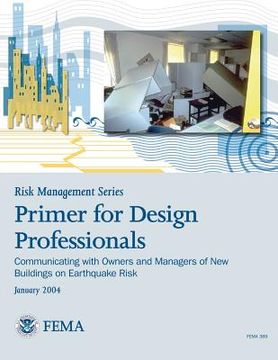Risk Management Series: Primer for Design Professionals: Communicating with Owners and Managers of New Buildings on Earthquake Risk (FEMA 389 (en Inglés)
Reseña del libro "Risk Management Series: Primer for Design Professionals: Communicating with Owners and Managers of New Buildings on Earthquake Risk (FEMA 389 (en Inglés)"
Seismic risk management tools, including new seismic engineering technology and data, are now available to assist with evaluating, predicting, and controlling financial and personal-injury losses from future damaging earthquakes. These tools have evolved as a result of scientific and engineering breakthroughs, including new earth-science knowledge about the occurrence and severity of earthquake shaking, and new engineering techniques for designing building systems and components to withstand the effects of earthquakes. As a result, design and construction professionals can now design and construct new buildings with more predictable seismic performance than ever before. Seismic risks can be managed effectively in a number of ways, including the design and construction of better performing buildings as well as the employment of strategies that can result in risk reduction over the life of the building. Risk reduction techniques include the use of new technologies, such as seismic isolation and energy dissipation devices for both structural and nonstructural systems; site selection to avoid hazards such as ground motion amplification, landslide, and liquefaction; and the use of performance-based design concepts, which enable the engineer to better estimate building capacity and seismic loading demand and to design buildings for enhanced performance (beyond that typically provided by current seismic codes). The implementation of risk reduction strategies by building owners and managers is critically important, not only for reducing the likelihood of life loss and injury, but also for reducing the potential for losses associated with earthquake damage repair and business interruption. The Federal Emergency Management Agency (FEMA) has commissioned and funded the development of this document to facilitate the process of educating building owners and managers about seismic risk management tools that can be effectively and economically employed by them during the building development phase - from site selection through design and construction - as well as the operational phase. The objectives of this report are fourfold: (1) to summarize, in a qualitative fashion, important new concepts in performance-based seismic design and new knowledge about the seismic hazard facing the United States (in a way that can be easily communicated to building owners and managers); (2) to describe a variety of concepts for reducing seismic risk, including the means to reduce economic losses that are not related to engineering solutions; (3) to provide illustrative examples and graphical tools that can be used by the design community to more effectively "sell" concepts of seismic risk management and building performance improvements; and (4) to establish a means by which seismic engineering and financial risk management can be integrated to form a holistic seismic risk management plan. The overarching goal of the document is to provide a means to facilitate communications between building owners/managers and design professionals on the important issues affecting seismic risk decision making during the design and construction of new facilities, as well as the operational phase. Stated another way, this report may be considered as a framework for integrating seismic risk management into already well-established project planning, design, and construction processes used by most owners and designers.

